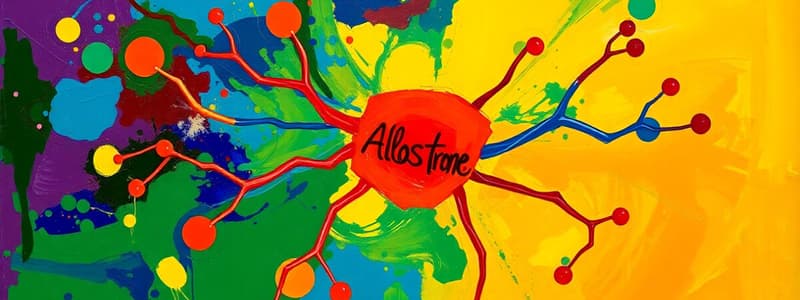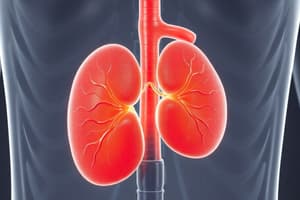Podcast
Questions and Answers
What is the primary chemical signal that triggers catecholamine secretion from the adrenal medulla?
What is the primary chemical signal that triggers catecholamine secretion from the adrenal medulla?
- Norepinephrine
- Acetylcholine (correct)
- Serotonin
- Dopamine
Which enzyme is primarily responsible for the degradation of catecholamines in neuronal mitochondria?
Which enzyme is primarily responsible for the degradation of catecholamines in neuronal mitochondria?
- Catechol-O-methyltransferase (COMT)
- Dopamine β-hydroxylase
- Monoamine oxidase (MAO) (correct)
- Tyrosine hydroxylase
How does cortisol influence epinephrine production in adrenal chromaffin cells?
How does cortisol influence epinephrine production in adrenal chromaffin cells?
- By increasing dopamine levels
- By promoting the release of ACh
- By inhibiting catecholamine synthesis
- By maintaining gene expression of PNMT (correct)
Which adrenergic receptor type primarily increases cyclic AMP levels in the heart?
Which adrenergic receptor type primarily increases cyclic AMP levels in the heart?
Which statement about the potency of epinephrine and norepinephrine at adrenergic receptors is correct?
Which statement about the potency of epinephrine and norepinephrine at adrenergic receptors is correct?
What primary physiological response do catecholamines evoke due to their direct innervation by the autonomic nervous system?
What primary physiological response do catecholamines evoke due to their direct innervation by the autonomic nervous system?
What mechanism primarily leads to the actions of catecholamines in target tissues?
What mechanism primarily leads to the actions of catecholamines in target tissues?
What is the approximate duration of action for circulating catecholamines in the body?
What is the approximate duration of action for circulating catecholamines in the body?
What is the primary hormonal product of the adrenal medulla?
What is the primary hormonal product of the adrenal medulla?
Which enzyme is responsible for converting norepinephrine to epinephrine in chromaffin cells?
Which enzyme is responsible for converting norepinephrine to epinephrine in chromaffin cells?
How does cortisol influence the differentiation of chromaffin cells in the adrenal medulla?
How does cortisol influence the differentiation of chromaffin cells in the adrenal medulla?
What effect does high extracellular potassium have on aldosterone synthesis?
What effect does high extracellular potassium have on aldosterone synthesis?
What mechanism regulates the synthesis of aldosterone when blood sodium and water levels are low?
What mechanism regulates the synthesis of aldosterone when blood sodium and water levels are low?
What hormones are primarily synthesized and stored in the adrenal medulla's chromaffin granules?
What hormones are primarily synthesized and stored in the adrenal medulla's chromaffin granules?
What primarily regulates the secretion of catecholamines from the adrenal medulla?
What primarily regulates the secretion of catecholamines from the adrenal medulla?
What is the main source of circulating norepinephrine in the body?
What is the main source of circulating norepinephrine in the body?
Which of the following conditions can increase the release of epinephrine from the adrenal medulla?
Which of the following conditions can increase the release of epinephrine from the adrenal medulla?
Which part of the central nervous system initiates sympathetic responses affecting catecholamine release?
Which part of the central nervous system initiates sympathetic responses affecting catecholamine release?
What can lead to a synergistic effect on the adrenal medulla's catecholamine response?
What can lead to a synergistic effect on the adrenal medulla's catecholamine response?
What is the primary storage medium for catecholamines in the adrenal medulla?
What is the primary storage medium for catecholamines in the adrenal medulla?
How much of the cells in the adrenal medulla secrete norepinephrine?
How much of the cells in the adrenal medulla secrete norepinephrine?
What factor does NOT contribute to the regulation of catecholamine secretion?
What factor does NOT contribute to the regulation of catecholamine secretion?
What percentage of circulating epinephrine is produced by the adrenal medulla?
What percentage of circulating epinephrine is produced by the adrenal medulla?
What is the overall goal of the sympathoadrenal system during exercise?
What is the overall goal of the sympathoadrenal system during exercise?
Which adrenergic receptor type primarily acts on the heart to increase contractility?
Which adrenergic receptor type primarily acts on the heart to increase contractility?
How does epinephrine affect blood glucose levels during physical stress?
How does epinephrine affect blood glucose levels during physical stress?
What physiological effect does norepinephrine have on visceral smooth muscle during stress?
What physiological effect does norepinephrine have on visceral smooth muscle during stress?
What is a symptom of pheochromocytoma caused by excessive catecholamine production?
What is a symptom of pheochromocytoma caused by excessive catecholamine production?
Which process is promoted by epinephrine to increase energy availability during exercise?
Which process is promoted by epinephrine to increase energy availability during exercise?
Which condition may require adrenalectomy and glucocorticoid therapy as part of its treatment?
Which condition may require adrenalectomy and glucocorticoid therapy as part of its treatment?
What effect does epinephrine have on lipolysis?
What effect does epinephrine have on lipolysis?
What is a primary method for diagnosing pheochromocytoma?
What is a primary method for diagnosing pheochromocytoma?
What is a physiological response common to the sympathoadrenal system?
What is a physiological response common to the sympathoadrenal system?
Which adrenal hormone is primarily responsible for regulating sodium retention in the kidney?
Which adrenal hormone is primarily responsible for regulating sodium retention in the kidney?
What stimulates the secretion of aldosterone in glomerulosa cells?
What stimulates the secretion of aldosterone in glomerulosa cells?
What is the principal action of aldosterone on renal function?
What is the principal action of aldosterone on renal function?
Which two catecholamines are produced in the adrenal medulla?
Which two catecholamines are produced in the adrenal medulla?
Which receptor subtype has the highest affinity for norepinephrine?
Which receptor subtype has the highest affinity for norepinephrine?
What does excessive exposure to epinephrine primarily lead to?
What does excessive exposure to epinephrine primarily lead to?
How does aldosterone exert its physiological effects?
How does aldosterone exert its physiological effects?
Which of the following is true regarding the synthesis of aldosterone?
Which of the following is true regarding the synthesis of aldosterone?
Which physiological change is primarily mediated by norepinephrine?
Which physiological change is primarily mediated by norepinephrine?
Which of the following hormones is involved in the regulation of osmolarity in the body?
Which of the following hormones is involved in the regulation of osmolarity in the body?
Flashcards
Catecholamine secretion trigger
Catecholamine secretion trigger
Acetylcholine (ACh) from preganglionic sympathetic neurons activates chromaffin cells in the adrenal medulla.
Tyrosine hydroxylase
Tyrosine hydroxylase
Rate-limiting enzyme in catecholamine synthesis.
Catecholamine degradation time
Catecholamine degradation time
Circulating catecholamines are short-lived, lasting about 10 seconds.
MAO
MAO
Signup and view all the flashcards
Adrenergic GPCRs
Adrenergic GPCRs
Signup and view all the flashcards
α1 receptor response
α1 receptor response
Signup and view all the flashcards
β2 receptor potency
β2 receptor potency
Signup and view all the flashcards
Adrenal medulla response time
Adrenal medulla response time
Signup and view all the flashcards
Sympathoadrenal response to exercise
Sympathoadrenal response to exercise
Signup and view all the flashcards
Epinephrine's effect on glycogenolysis
Epinephrine's effect on glycogenolysis
Signup and view all the flashcards
Lipolysis in exercise
Lipolysis in exercise
Signup and view all the flashcards
Sympathoadrenal response to visceral smooth muscle
Sympathoadrenal response to visceral smooth muscle
Signup and view all the flashcards
Pheochromocytoma
Pheochromocytoma
Signup and view all the flashcards
Pheochromocytoma symptoms
Pheochromocytoma symptoms
Signup and view all the flashcards
Diagnosis of Pheochromocytoma
Diagnosis of Pheochromocytoma
Signup and view all the flashcards
Treatment of Pheochromocytoma
Treatment of Pheochromocytoma
Signup and view all the flashcards
Cardiac response to Epinephrine/Norepinephrine
Cardiac response to Epinephrine/Norepinephrine
Signup and view all the flashcards
Glucose availability during exercise
Glucose availability during exercise
Signup and view all the flashcards
Adrenal Medulla Function
Adrenal Medulla Function
Signup and view all the flashcards
Catecholamine Storage
Catecholamine Storage
Signup and view all the flashcards
Epinephrine vs. Norepinephrine Ratio
Epinephrine vs. Norepinephrine Ratio
Signup and view all the flashcards
Catecholamine Transport
Catecholamine Transport
Signup and view all the flashcards
Regulation of Adrenal Medulla
Regulation of Adrenal Medulla
Signup and view all the flashcards
Stress & Catecholamine Response
Stress & Catecholamine Response
Signup and view all the flashcards
Catecholamine Control Centers
Catecholamine Control Centers
Signup and view all the flashcards
Norepinephrine Source
Norepinephrine Source
Signup and view all the flashcards
Adrenal Medulla Necessity
Adrenal Medulla Necessity
Signup and view all the flashcards
Chromaffin Granules
Chromaffin Granules
Signup and view all the flashcards
Aldosterone Regulation
Aldosterone Regulation
Signup and view all the flashcards
Aldosterone Production Trigger (High K+)
Aldosterone Production Trigger (High K+)
Signup and view all the flashcards
Adrenal Cortex Development
Adrenal Cortex Development
Signup and view all the flashcards
Cortisol's Role in Medulla
Cortisol's Role in Medulla
Signup and view all the flashcards
ROMK/ENaC Channels
ROMK/ENaC Channels
Signup and view all the flashcards
Aldosterone class
Aldosterone class
Signup and view all the flashcards
Aldosterone synthesis site
Aldosterone synthesis site
Signup and view all the flashcards
Renin-angiotensin system
Renin-angiotensin system
Signup and view all the flashcards
Aldosterone kidney effect
Aldosterone kidney effect
Signup and view all the flashcards
Adrenoceptor subtypes
Adrenoceptor subtypes
Signup and view all the flashcards
Catecholamine types
Catecholamine types
Signup and view all the flashcards
Extracellular fluid volume (ECV)
Extracellular fluid volume (ECV)
Signup and view all the flashcards
Osmolality regulation
Osmolality regulation
Signup and view all the flashcards
Aldosterone plasma binding
Aldosterone plasma binding
Signup and view all the flashcards
Aldosterone synthesis rate
Aldosterone synthesis rate
Signup and view all the flashcards
Study Notes
Adrenal Gland and Adrenal Hormones
- Aldosterone, epinephrine, and norepinephrine belong to a class of steroid hormones.
- Aldosterone is synthesized in the zona glomerulosa of the adrenal cortex.
- Norepinephrine and epinephrine are synthesized in the adrenal medulla.
Aldosterone: Function and Regulation
- Aldosterone regulates extracellular volume (ECV) by acting on Na+ retention/absorption in the kidneys.
- Arginine vasopressin (AVP)/antidiuretic hormone (ADH) regulates osmolality by affecting free water balance and Na+ concentration.
- Osmolarity is maintained at 300 mOs/L.
- Aldosterone synthesis is regulated by the renin-angiotensin-aldosterone system (RAAS).
Aldosterone: Synthesis
- Aldosterone is synthesized from cholesterol.
- The zona glomerulosa is the exclusive site of aldosterone synthesis.
- Aldosterone secretion is limited by the rate of synthesis in the glomerulosa cells.
- ACTH, extracellular K+, and ANG II stimulate aldosterone production.
- Enzymes such as SCC and aldosterone synthase are crucial in the synthesis process.
- ~37% of circulating aldosterone stays free in plasma; the rest binds to CBG (~21%) and albumin (~42%).
Aldosterone: Mechanism of Action
- The primary action of aldosterone is to stimulate kidney Na+ reabsorption/water reabsorption and enhance potassium secretion.
- MRs are present in tissues like the myocardium, liver, brain and others.
- Aldosterone modulates gene transcription after binding to the MR.
- Aldosterone regulates a small fraction of renal Na+ reabsorption in the distal tubule and collecting duct.
- Loss of aldosterone-mediated Na+ reabsorption leads to electrolyte abnormalities like hyperkalemia, and hypotension.
- Excess aldosterone results in hypokalemia and hypertension.
- Increased Na+ reabsorption results in a 3L change in extracellular volume with only a 2% change in Na+ excretion.
Aldosterone: Regulation of Synthesis
- Na and water levels feedback through the RAAS.
- Ang II binds to receptors, triggering a cascade leading to Ca2+ increase and activating enzymes (P450scc, CYP11A1) that promote cholesterol delivery and aldosterone synthesis.
- High extracellular K+ also depolarizes glomerulosa cells, opening Ca2+ channels, stimulating aldosterone synthesis.
- ACTH also stimulates production of aldosterone and P450scc (desmolase, CYP11A1).
- Binding to MC2R stimulates Ca2+ inflow.
Feedback Regulation of Aldosterone Synthesis
- Blood K+ level increases, triggering aldosterone release.
- Aldosterone targets kidneys, causing K+ release and blood Na+/K+ levels returning to normal.
- Feedback inhibition occurs based on blood Na+ levels.
Adrenal Medulla: Catecholamines
- Adrenal medulla synthesizes catecholamines such as epinephrine and norepinephrine.
- Catecholamines are stored in chromaffin granules with ATP, calcium and protein complexes (chromogranins).
- Catecholamines, particularly epinephrine, are derived entirely from the adrenal medulla.
Development of the Adrenal Gland
- The adrenal cortex develops from mesodermal cells.
- Neural crest-derived chromaffin cells migrate into the cortex to form the medulla.
- Cortisol inhibits neuronal differentiation of chromaffin cells.
- Cortisol induces PNMT expression in chromaffin cells, converting norepinephrine to epinephrine.
Adrenal Medulla Actions
- The adrenal medulla bridges the endocrine and sympathetic nervous systems.
- Adrenomedullary catecholamines are secreted into the bloodstream and act as hormones.
- Chromaffin cells release epinephrine and norepinephrine directly into the blood.
Regulation of Catecholamines
- Secretion of epinephrine and norepinephrine is primarily regulated by descending sympathetic signals in response to stress.
- Hypothalamus, brainstem, cerebral cortex, and limbic system are involved in initiation of sympathetic responses.
- Acetylcholine (ACh) stimulates catecholamine release by activating tyrosine hydroxylase and dopamine β-hydroxylase, stimulating exocytosis of chromaffin granules.
Degradation of Catecholamines
- Biological response of catecholamines is short-lived (~10 seconds).
- Monoamine oxidase (MAO) and catechol-O-methyltransferase (COMT) are primary degradation enzymes.
Mechanism of Action of Catecholamines
- Catecholamines act via adrenergic GPCRs (G protein-coupled receptors).
- Different receptors (α1, α2, β1, β2, β3) mediate diverse effects, with varied sensitivities to norepinephrine and epinephrine.
- A single catecholamine can evoke multiple effects (e.g., vasodilation and vasoconstriction) depending on the circulating concentration and receptor activation.
Physiological Actions of Catecholamines
- Catecholamine responses are very fast due to direct autonomic nervous system innervation.
- Responses can anticipate stress, e.g., exercise.
- Catecholamines increase energy supply, increasing cardiac output, blood glucose, and decreasing energy use in the Gl tract and urinary tract.
Pheochromocytoma
- An uncommon tumor caused by hyperplasia of the adrenal medulla or other chromaffin tissue.
- Characterized by excessive, unregulated catecholamine production.
- Symptoms include sudden hypertension, headaches, sweating, anxiety, tremor, and glucose intolerance.
- Diagnosis and treatment require detecting urinary catecholamines and metabolites, often involving adrenalectomy and hormone replacement therapy.
Studying That Suits You
Use AI to generate personalized quizzes and flashcards to suit your learning preferences.




